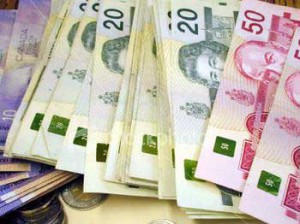 THUNDER BAY – The current mayhem on world stock markets and the threat of another recession invariably generate questions as to what is happening and why. Of course, what is presently occurring on world markets is linked to the mortgage loan and financial crisis of 2008 and the ensuing global recession. In essence, prior to 2008, the world economy had a big party, which involved a lot of debt financing. Not everyone was invited to the party but those that attended had a great time. The party ended, but now everyone has to help clean up – whether they attended the party or not. In simple terms, this is the crux of the matter.
THUNDER BAY – The current mayhem on world stock markets and the threat of another recession invariably generate questions as to what is happening and why. Of course, what is presently occurring on world markets is linked to the mortgage loan and financial crisis of 2008 and the ensuing global recession. In essence, prior to 2008, the world economy had a big party, which involved a lot of debt financing. Not everyone was invited to the party but those that attended had a great time. The party ended, but now everyone has to help clean up – whether they attended the party or not. In simple terms, this is the crux of the matter.
In the wake of the financial crisis and the recession, government stimulus programs bought time but after three years, mountains of private debt have been augmented with mountains of public debt and the world economy has still not started growing in a manner that would assist in dealing with the debts. The U.S. economy is still mired in slower economic growth. Europe is still facing debt problems not just in Greece but also in the larger economies of Italy and Spain. Add into this the reluctance of politicians to face their debts as most recently illustrated in the U.S. debt ceiling debate and it is no wonder that world stock markets have decided that things are not so good. There is a lot of debt to unwind and it basically means that there is going to be a lot less consumption in the immediate future both publicly and privately. This was apparent before Standard and Poor’s downgraded the U.S. debt – at best their downgrade was a match that lit the highly combustible world financial situation.
Debt is a tool that enables individuals and government deal with large capital purchases or short-term fluctuations in purchasing power. Used responsibly, it allows people to buy a house, companies to finance expansions, and governments to build infrastructure. Used irresponsibly, it becomes a way to fuel current consumption and short term growth and postpone the day of reckoning which when it arrives can be quite brutal if the economy has slowed or interest rates are rising. Part of the solution to the current situation requires governments and individuals taking responsibility for their current debts and institutional mechanisms that prevent the future irresponsible accumulation of both private and public debt. In many respects, there is a crisis of confidence in world economic leadership and that confidence needs to be restored before progress can be made in dealing with debt and world economic growth.
The leaders of the G-20 need to come together and create a new global sovereign debt stabilization fund (a global bailout package for lack of a better term) that in essence safeguards debt issues either through the World Bank or IMF or as part of a new institutional arrangement. Coupled with this would need to be conditions for countries to deal with their fiscal deficits over a three to five year period with credible plans to restructure their finances as well as transition payments (in essence a form of global equalization grant program) from the new global fund to deal with the shock of adjustment. In essence, this is a crisis in confidence and the current ad hoc approach needs to be replaced with the structure of a more formal mechanism that will generate the confidence in the world financial system needed to restore stability in world markets.
What about Canada? Well, Canada is in comparatively good shape but the indicators suggest concern. For Canada, there are high levels of private debt and public sector debt has grown but not to the extent that it has in Europe or the United States. However, watch out for the value of our dollar. Oddly enough, while the United States received the debt downgrade, the value of its dollar rose relative to ours. The U.S. problem is not the debt ceiling debate or the Standard and Poor’s downgrade but its lack of a credible long-term plan to resolve its debt issues and a very anemic economy. Its debt instruments – treasury bills – are still seen as a safe store of value. A weak United States economy means a drop in demand for Canadian exports and a slower economy – hence a drop in our dollar’s value.
Livio Di Matteo
 Livio Di Matteo is an economist in Thunder Bay, Ontario specializing in public policy, health economics, public finance and economic history. Livio Di Matteo is a graduate of the Fort William Collegiate Institute (1898-2005) whose school motto “Agimus Meliora” has served as a personal inspiration. Livio Di Matteo holds a PhD from McMaster University, an MA from the University of Western Ontario and an Honours BA from Lakehead University. He is Professor of Economics at Lakehead University where he has served since 1990. His research has explored the sustainability of provincial government health spending, historical wealth and asset holding and economic performance and institutions in Northwestern Ontario and the central North American economic region. His historical wealth research using census-linked probate records is funded by grants from the Social Sciences and Humanities Research Council of Canada. He has constructed, assembled and analyzed nearly 12,000 estate files for Ontario over the period 1870 to 1930. Livio Di Matteo writes and comments on public policy and his articles have appeared in the National Post, Toronto Star, the Winnipeg Free Press and Thunder Bay Chronicle-Journal and NetNewsledger.com. Livio Di Matteo has had an entry in Canadian Who’s Who since 1995.
Livio Di Matteo is an economist in Thunder Bay, Ontario specializing in public policy, health economics, public finance and economic history. Livio Di Matteo is a graduate of the Fort William Collegiate Institute (1898-2005) whose school motto “Agimus Meliora” has served as a personal inspiration. Livio Di Matteo holds a PhD from McMaster University, an MA from the University of Western Ontario and an Honours BA from Lakehead University. He is Professor of Economics at Lakehead University where he has served since 1990. His research has explored the sustainability of provincial government health spending, historical wealth and asset holding and economic performance and institutions in Northwestern Ontario and the central North American economic region. His historical wealth research using census-linked probate records is funded by grants from the Social Sciences and Humanities Research Council of Canada. He has constructed, assembled and analyzed nearly 12,000 estate files for Ontario over the period 1870 to 1930. Livio Di Matteo writes and comments on public policy and his articles have appeared in the National Post, Toronto Star, the Winnipeg Free Press and Thunder Bay Chronicle-Journal and NetNewsledger.com. Livio Di Matteo has had an entry in Canadian Who’s Who since 1995.
This article was originally posted on Livio Di Matteo’s NORTHERN ECONOMIST Blog at http://ldimatte.shawwebspace.ca.


